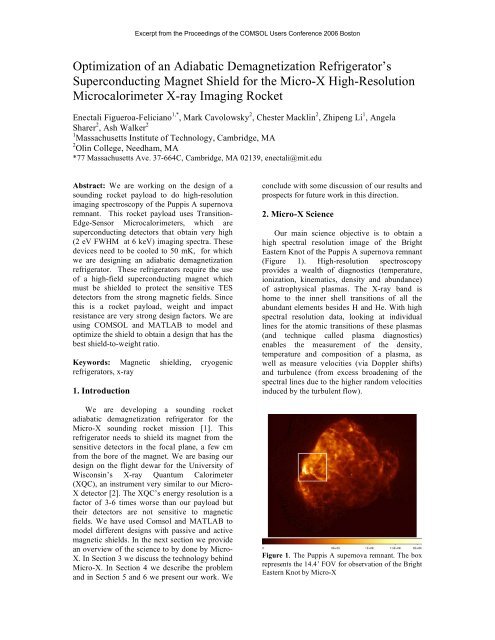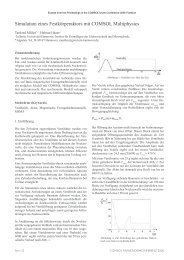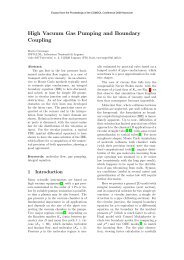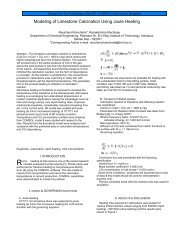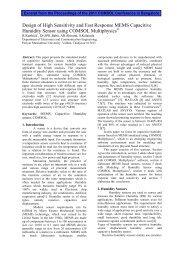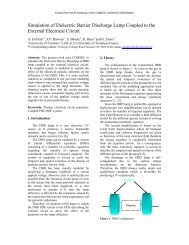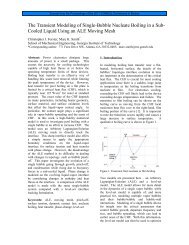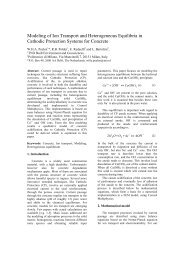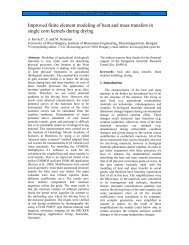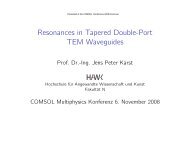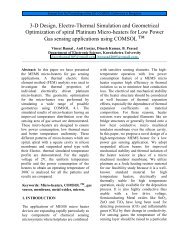Optimization of an Adiabatic Demagnetization ... - COMSOL.com
Optimization of an Adiabatic Demagnetization ... - COMSOL.com
Optimization of an Adiabatic Demagnetization ... - COMSOL.com
You also want an ePaper? Increase the reach of your titles
YUMPU automatically turns print PDFs into web optimized ePapers that Google loves.
<strong>Optimization</strong> <strong>of</strong> <strong>an</strong> <strong>Adiabatic</strong> <strong>Demagnetization</strong> Refrigerator’s<br />
Superconducting Magnet Shield for the Micro-X High-Resolution<br />
Microcalorimeter X-ray Imaging Rocket<br />
Enectali Figueroa-Felici<strong>an</strong>o 1,* , Mark Cavolowsky 2 , Chester Macklin 2 , Zhipeng Li 1 , Angela<br />
Sharer 2 , Ash Walker 2<br />
1<br />
Massachusetts Institute <strong>of</strong> Technology, Cambridge, MA<br />
2<br />
Olin College, Needham, MA<br />
*77 Massachusetts Ave. 37-664C, Cambridge, MA 02139, enectali@mit.edu<br />
Abstract: We are working on the design <strong>of</strong> a<br />
sounding rocket payload to do high-resolution<br />
imaging spectroscopy <strong>of</strong> the Puppis A supernova<br />
remn<strong>an</strong>t. This rocket payload uses Tr<strong>an</strong>sition-<br />
Edge-Sensor Microcalorimeters, which are<br />
superconducting detectors that obtain very high<br />
(2 eV FWHM at 6 keV) imaging spectra. These<br />
devices need to be cooled to 50 mK, for which<br />
we are designing <strong>an</strong> adiabatic demagnetization<br />
refrigerator. These refrigerators require the use<br />
<strong>of</strong> a high-field superconducting magnet which<br />
must be shielded to protect the sensitive TES<br />
detectors from the strong magnetic fields. Since<br />
this is a rocket payload, weight <strong>an</strong>d impact<br />
resist<strong>an</strong>ce are very strong design factors. We are<br />
using <strong>COMSOL</strong> <strong>an</strong>d MATLAB to model <strong>an</strong>d<br />
optimize the shield to obtain a design that has the<br />
best shield-to-weight ratio.<br />
Keywords: Magnetic shielding, cryogenic<br />
refrigerators, x-ray<br />
1. Introduction<br />
Excerpt from the Proceedings <strong>of</strong> the <strong>COMSOL</strong> Users Conference 2006 Boston<br />
We are developing a sounding rocket<br />
adiabatic demagnetization refrigerator for the<br />
Micro-X sounding rocket mission [1]. This<br />
refrigerator needs to shield its magnet from the<br />
sensitive detectors in the focal pl<strong>an</strong>e, a few cm<br />
from the bore <strong>of</strong> the magnet. We are basing our<br />
design on the flight dewar for the University <strong>of</strong><br />
Wisconsin’s X-ray Qu<strong>an</strong>tum Calorimeter<br />
(XQC), <strong>an</strong> instrument very similar to our Micro-<br />
X detector [2]. The XQC’s energy resolution is a<br />
factor <strong>of</strong> 3-6 times worse th<strong>an</strong> our payload but<br />
their detectors are not sensitive to magnetic<br />
fields. We have used Comsol <strong>an</strong>d MATLAB to<br />
model different designs with passive <strong>an</strong>d active<br />
magnetic shields. In the next section we provide<br />
<strong>an</strong> overview <strong>of</strong> the science to by done by Micro-<br />
X. In Section 3 we discuss the technology behind<br />
Micro-X. In Section 4 we describe the problem<br />
<strong>an</strong>d in Section 5 <strong>an</strong>d 6 we present our work. We<br />
conclude with some discussion <strong>of</strong> our results <strong>an</strong>d<br />
prospects for future work in this direction.<br />
2. Micro-X Science<br />
Our main science objective is to obtain a<br />
high spectral resolution image <strong>of</strong> the Bright<br />
Eastern Knot <strong>of</strong> the Puppis A supernova remn<strong>an</strong>t<br />
(Figure 1). High-resolution spectroscopy<br />
provides a wealth <strong>of</strong> diagnostics (temperature,<br />
ionization, kinematics, density <strong>an</strong>d abund<strong>an</strong>ce)<br />
<strong>of</strong> astrophysical plasmas. The X-ray b<strong>an</strong>d is<br />
home to the inner shell tr<strong>an</strong>sitions <strong>of</strong> all the<br />
abund<strong>an</strong>t elements besides H <strong>an</strong>d He. With high<br />
spectral resolution data, looking at individual<br />
lines for the atomic tr<strong>an</strong>sitions <strong>of</strong> these plasmas<br />
(<strong>an</strong>d technique called plasma diagnostics)<br />
enables the measurement <strong>of</strong> the density,<br />
temperature <strong>an</strong>d <strong>com</strong>position <strong>of</strong> a plasma, as<br />
well as measure velocities (via Doppler shifts)<br />
<strong>an</strong>d turbulence (from excess broadening <strong>of</strong> the<br />
spectral lines due to the higher r<strong>an</strong>dom velocities<br />
induced by the turbulent flow).<br />
Figure 1. The Puppis A supernova remn<strong>an</strong>t. The box<br />
represents the 14.4’ FOV for observation <strong>of</strong> the Bright<br />
Eastern Knot by Micro-X
Excerpt from the Proceedings <strong>of</strong> the <strong>COMSOL</strong> Users Conference 2006 Boston<br />
Figure 2. Simulation <strong>of</strong> the integrated Puppis A spectrum assuming a 300 sec observation by Micro-X with 2 eV<br />
FWHM spectral resolution. There are 92,000 counts in this simulation.<br />
The Puppis A supernova remn<strong>an</strong>t (SNR) is a<br />
bright, middle-aged Galactic supernova remn<strong>an</strong>t<br />
(~ 4000 years old) straddling the division<br />
between young SNRs that are totally dominated<br />
by their own ejected debris (from the SNR<br />
explosion) <strong>an</strong>d older remn<strong>an</strong>ts that have lost all<br />
trace <strong>of</strong> their ejecta <strong>an</strong>d now are seen through<br />
their inteaction with the local interstellar<br />
material. Puppis A still shows evidence <strong>of</strong> its<br />
explosion ejecta while at the same time being<br />
very strongly shaped by its interactions with a<br />
<strong>com</strong>plex interstellar environment. The Bright<br />
Eastern Knot (BEK) region <strong>of</strong> Puppis A is the<br />
brightest, <strong>an</strong>d perhaps most <strong>com</strong>plex example <strong>of</strong><br />
these interactions, with multiple shocked clouds<br />
plus evidence for ejecta in its vicinity. Figure 1<br />
shows a picture taken by the Rosat X-ray<br />
satellite <strong>of</strong> Puppis A.<br />
The main sciece goal <strong>of</strong> Micro-X is to<br />
unravel the kinematic, temperature, <strong>an</strong>d<br />
ionization characteristics <strong>of</strong> the cloud shock<br />
interactions at the BEK <strong>an</strong>d search for traces <strong>of</strong><br />
the original ejecta <strong>of</strong> SNR (Figure 2). Crucial to<br />
both <strong>of</strong> these efforts will be determining the<br />
temperature distribution <strong>of</strong> the X-ray emitting<br />
gas. This is import<strong>an</strong>t for underst<strong>an</strong>ding ejecta<br />
enrichment because multi-temperature gas c<strong>an</strong><br />
mimic enriched abund<strong>an</strong>ces (the sign <strong>of</strong> ejecta<br />
material) in lower resoluition spectra. Our<br />
expected high energy reolution will allow us to<br />
unambiguously determine the state <strong>of</strong> the plasma<br />
through the identification <strong>an</strong>d <strong>an</strong>alysis <strong>of</strong> its<br />
spectral lines.<br />
3. The Micro-X instrument<br />
At this time, two X-ray space telescopes in<br />
orbit – the XMM-Newton <strong>an</strong>d Ch<strong>an</strong>dra space<br />
telescopes – are capable <strong>of</strong> high resolution X-ray<br />
spectra through grating spectrometers. Grating<br />
spectrometers work well at lower energies (.2 - 2<br />
keV) but are degraded when looking at extended<br />
sources. Although some progress has been made<br />
in <strong>an</strong>alyzing extened sources with XMM-<br />
Newton, the very high resolutions available for<br />
point sources remain unattainable for low surface<br />
brightness extended objects.<br />
Micro-X will use a 11 X 11 array <strong>of</strong> X-ray<br />
microcalorimeters designed <strong>an</strong>d developed at the<br />
NASA Goddard Space Flight Center. Figure 3<br />
shows a schematic for <strong>an</strong> X-ray<br />
microcalorimeter. The device operates at<br />
cryogenic temperatures to minimize noise from<br />
thermal fluctuations. It senses the temperature
Excerpt from the Proceedings <strong>of</strong> the <strong>COMSOL</strong> Users Conference 2006 Boston<br />
Figure 3. Basic Microcalorimeter. An X-ray<br />
absorber cooled by a refrigerator <strong>an</strong>d connected to a<br />
cold bath senses a photons energy by the increase in<br />
temperature from the photon’s thermalization.<br />
pulse caused by a photon thermalization event<br />
<strong>an</strong>d estimates the energy <strong>of</strong> the photon based on<br />
the pulse height <strong>of</strong> the temperature pulse.<br />
Microcalorimeters use one <strong>of</strong> the world’s most<br />
sensitive thermometers, the Tr<strong>an</strong>sition-Edge<br />
Sensor (TES). A TES is a superconducting film<br />
biased in its tr<strong>an</strong>sition. Ch<strong>an</strong>ges in temperature<br />
cause ch<strong>an</strong>ges in the resist<strong>an</strong>ce <strong>of</strong> the TES film.<br />
4. The Micro-X <strong>Adiabatic</strong> <strong>Demagnetization</strong><br />
Refrigerator <strong>an</strong>d the Shielding<br />
Problem<br />
In order to cool the mircrocalorimeter, we are<br />
designing a rocket-flight-qualified <strong>Adiabatic</strong><br />
<strong>Demagnetization</strong> Refrigerator (ADR) for Micro-<br />
X. This unit will need to survive 17 g’s <strong>of</strong><br />
acceleration during launch, <strong>an</strong>d up to 200 g’s <strong>of</strong><br />
deceleration during l<strong>an</strong>ding. An ADR uses a<br />
powerful 4 Tesla magnet to orient the spins in a<br />
salt <strong>an</strong>d then adiabatically cools the salt by<br />
removing the field <strong>an</strong>d allowing the spins in the<br />
salt to r<strong>an</strong>domize. Our TES detectors are very<br />
sensitive to magnetic fields, so a shield is needed<br />
to protect the TESs from the ADR’s magnet. The<br />
requirements <strong>of</strong> the design are to minimize the<br />
ADR’s magnetic field in the region around the<br />
TES detectors while minimizing the weight <strong>of</strong><br />
the shield. Because we must withst<strong>an</strong>d high g<br />
forces, the larger the mass, the more stress is<br />
placed on the ADR during acceleration. Thus the<br />
parameter we wish to optimize is the reduction in<br />
field at the detector stage per unit mass <strong>of</strong> shield.<br />
5. Solution 1: Passive Shielding<br />
We have simulated several passive shield<br />
designs using <strong>COMSOL</strong>. Passive shielding refers<br />
to using high-permeability materials around the<br />
magnet to keep the magnetic field close to the<br />
magnet <strong>an</strong>d provide shielding. Passive shielding<br />
works very well in low field environments, but<br />
in high-field environments the saturation effect,<br />
where the material’s permeability ch<strong>an</strong>ges nonlinearly<br />
to that <strong>of</strong> free space as the field<br />
approaches some critical value, makes the design<br />
<strong>of</strong> passive shields very <strong>com</strong>plex. We have<br />
successfully modeled this non-linear<br />
permeability in <strong>COMSOL</strong> <strong>an</strong>d have written<br />
MATLAB scripts to iterate on different designs<br />
to obtain the best sielding for a given amount <strong>of</strong><br />
mass.<br />
Figure’s 4 <strong>an</strong>d 5 show a simulation for <strong>an</strong><br />
axially symmetric model in <strong>COMSOL</strong>. In Figure<br />
5 the field for a 5 Tesla magnet is shown. The<br />
image is stretched to show regions above 2.5<br />
Tesla in white. 2.5 T is the saturation field <strong>of</strong> the<br />
V<strong>an</strong>adium Permadur, so areas <strong>of</strong> the shield that<br />
are white are fully saturated. M<strong>an</strong>y iterations on<br />
this design were attempted to try to find<br />
geometries where saturation did not occur. We<br />
defined the shield efficiency as the value <strong>of</strong> the<br />
magnetic field attenuation at the detector divided<br />
by the mass <strong>of</strong> the shield. This design had <strong>an</strong><br />
efficiency <strong>of</strong> around 40.<br />
Figure 4. A model for the Micro-X ADR shield. R2 is<br />
the magnet, <strong>an</strong>d R3 is the salt pill, which has its<br />
permeability set to 1 for this simulation. R6 <strong>an</strong>d C02<br />
are V<strong>an</strong>adium Permadur shields, <strong>an</strong>d R4 is the<br />
detector region <strong>of</strong> interest.
Excerpt from the Proceedings <strong>of</strong> the <strong>COMSOL</strong> Users Conference 2006 Boston<br />
Figure 5. The magnetic field for the model in Figure<br />
4. Shield sections in white are fully saturated.<br />
Figure 6. Best design for passive shielding. A<br />
<strong>com</strong>bination <strong>of</strong> both V<strong>an</strong>adium Permadur (thick<br />
shield) <strong>an</strong>d Cryoperm (thin washer-style shield)<br />
provides a very low field in the detector region.<br />
After running m<strong>an</strong>y simulations by ch<strong>an</strong>ging<br />
the geometry <strong>of</strong> the shield <strong>an</strong>d using both<br />
V<strong>an</strong>adium Permadur <strong>an</strong>d Cryoperm (which has a<br />
higher permeability but lower saturation field<br />
th<strong>an</strong> V<strong>an</strong>adium Permadur) we arrived at the<br />
design on Figure 6. In this design there is a thick<br />
cylinder <strong>of</strong> VP that wraps under the magnet, with<br />
two flat large washers <strong>of</strong> cryoperm on the top<br />
<strong>an</strong>d bottom <strong>of</strong> the shield. This high permeability<br />
material is placed farther away from the magnet<br />
so it does not saturate during full field.<br />
Although these designs will provide small<br />
enough fields to work, their mass is still larger<br />
th<strong>an</strong> we desire. To try to bring the field around<br />
the detector down when at full magnet field, we<br />
looked at active shielding.<br />
6. Solution 2: Active Shielding<br />
Active shielding consists <strong>of</strong> placing a so<br />
called “bucking coil” (a magnet wound in the<br />
opposite direction <strong>of</strong> the main magnet) at a<br />
location nulls the field at the desired low-field<br />
region while maintaining the large field at the<br />
magnet bore. The adv<strong>an</strong>tage <strong>of</strong> active shielding<br />
is that the current through the bucking coil is<br />
proportional to the current in the main coil, so<br />
the attenuation is linear in current. There is not<br />
saturation effect, so active shields are very<br />
<strong>com</strong>petitive at high fields. The drawback to<br />
active shields is that at low currents their<br />
attenuation is usually lower th<strong>an</strong> what c<strong>an</strong> be<br />
achieved with the high permeability materials.<br />
We modeled a series <strong>of</strong> bucking coils with<br />
different geometries but keeping the total mass<br />
<strong>of</strong> the bucking coil const<strong>an</strong>t. To do this a<br />
MATLAB routine was created that kept the<br />
volume <strong>of</strong> the bucking coil const<strong>an</strong>t while<br />
ch<strong>an</strong>ging its geometry. In this model our target<br />
field in the detector volume was less th<strong>an</strong> 0.05<br />
Tesla at full magnet field. This would allow the<br />
design <strong>of</strong> a superconducting shield around the<br />
detectors that would not saturate during the<br />
magnet cycle. Figure 7 shows one <strong>of</strong> the<br />
optimization designs that has a tubular style<br />
bucking coil. The colors have been stretched so<br />
that <strong>an</strong>y region above 0.05 Tesla is white. The<br />
large horizontal box below the magnet is the<br />
desired low field area. As c<strong>an</strong> be seen, this<br />
bucking coil design meets the requirements.<br />
Figure 8 shows <strong>an</strong>other bucking coil with the<br />
same volume as that in Figure 7, but in a more<br />
horizontally spread out washer design. This<br />
design creates a more homogeneous low field<br />
region.
Excerpt from the Proceedings <strong>of</strong> the <strong>COMSOL</strong> Users Conference 2006 Boston<br />
Figure 7. Bucking coil design for Micro-X. Here the<br />
bucking coil is fairly tubular, but creates a low field<br />
region within the 0.05 T requirements in the detector<br />
area (long rect<strong>an</strong>gular region below the magnet.<br />
Figure 8. Best design for active shielding. This<br />
washer-style bucking coil has the same volume at the<br />
bucking coil in Figure 7, but its more horizontally<br />
spread out shape creates a more uniform low field<br />
region.<br />
7. Conclusions <strong>an</strong>d Future Work<br />
We have begun the design <strong>of</strong> a active/passive<br />
shield for the Micro-X sounding rocket payload.<br />
We successfully implemented a non-linear solver<br />
<strong>an</strong>d simulated saturation effects in highpermeability<br />
materials using <strong>COMSOL</strong>.<br />
MATLAB was used to step through different<br />
geometries <strong>an</strong>d iterate designs. Output from<br />
<strong>COMSOL</strong> for each iteration was evaluated by<br />
MATLAB to provide feedback <strong>an</strong>d metrics for<br />
the perform<strong>an</strong>ce <strong>of</strong> each design.<br />
Our next step is to <strong>com</strong>bine both approaches<br />
<strong>an</strong>d design a low-mass active <strong>an</strong>d passive shield<br />
that keeps the detector area field low at full<br />
magnet field while having a large attenuation<br />
factor at lower magnet fields when the detector is<br />
operating. We will continue using <strong>COMSOL</strong> <strong>an</strong>d<br />
MATLAB as <strong>an</strong> effective platform for magnetic<br />
shield design. Future designs may incorporate<br />
non-axially symmetric elements which will<br />
require a 3D simulation to be done.<br />
8. References<br />
1. Figueroa-Felici<strong>an</strong>o, E et al., Science with<br />
Micro-X: The TES microcalorimeter x-ray<br />
imaging rocket, SPIE, 6266, 62660A (2006)<br />
2. McCammon, D. et al., A High Spectral<br />
Resolution Observation <strong>of</strong> the S<strong>of</strong>t X-Ray<br />
Diffuse Background With Thermal Detectors,<br />
The Astrophysical Journal, 576, 188-203 (2002)


